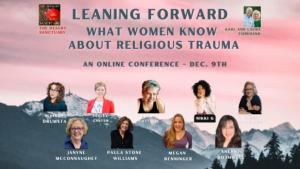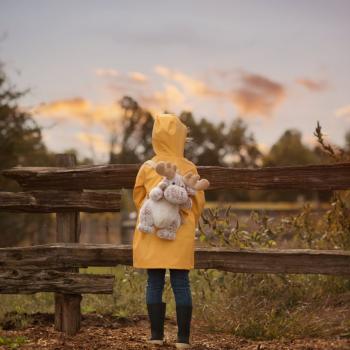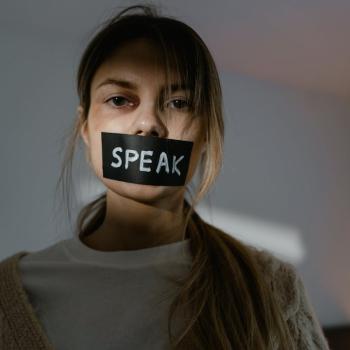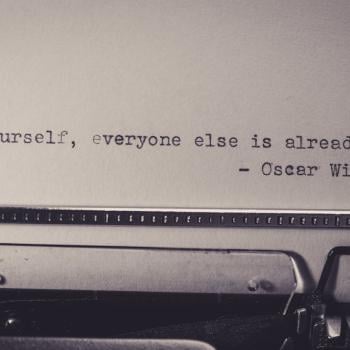Tending the Wounds of Religious Trauma
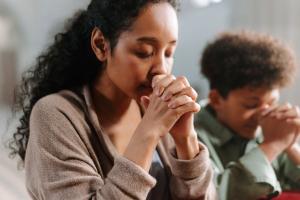
I was lucky to create a conference called Leaning Forward with all these women and their wisdom!
Leaning Forward is the title of a book by Karl and Laura Forehand about moving beyond the confines of organized religion. It is also the title of an online conference we have hosted for several years. This year, we decided to host a series of podcasts primarily to help us understand religious trauma and how to move forward. We are also hosting an online conference with the understanding that amplifying women’s voices is probably the most important component.
Preview – Transcript &Video Below
Tending the Wounds of Religious Trauma with Rebekah Drumsta
Transcript – Video Below
Hello, my name is Rebeca Drumsta. I am a survivor of four different religious cults, so when I say that I understand what religious trauma looks like, I mean it, because I’ve lived on so many different levels and I say that I’m a Survivor of four different ones. Those experiences have impacted my life because some of my first childhood memories are when I was five years old.
One of them was on a church playground and I was just swinging and doing the slides and, suddenly, this little girl walked up to me with handfuls of sand, and she just threw them into my eyes, blinding me and scaring me to death. Then, she started yelling at me. She had to be around my age, and she said that my family was going to hell and that no one could ever talk to us again because we were leaving that church and we were changing denominations.
Being five years old, I remember my father’s good friend was murdered. The reason he was murdered was that he had removed his family from a Mormon sect down in Mexico to become members of our church, the one that we eventually left. But they wanted the children back and he refused to send his children back to Mexico to be part of this Mormon sect and as an atonement, his blood had to be shed.
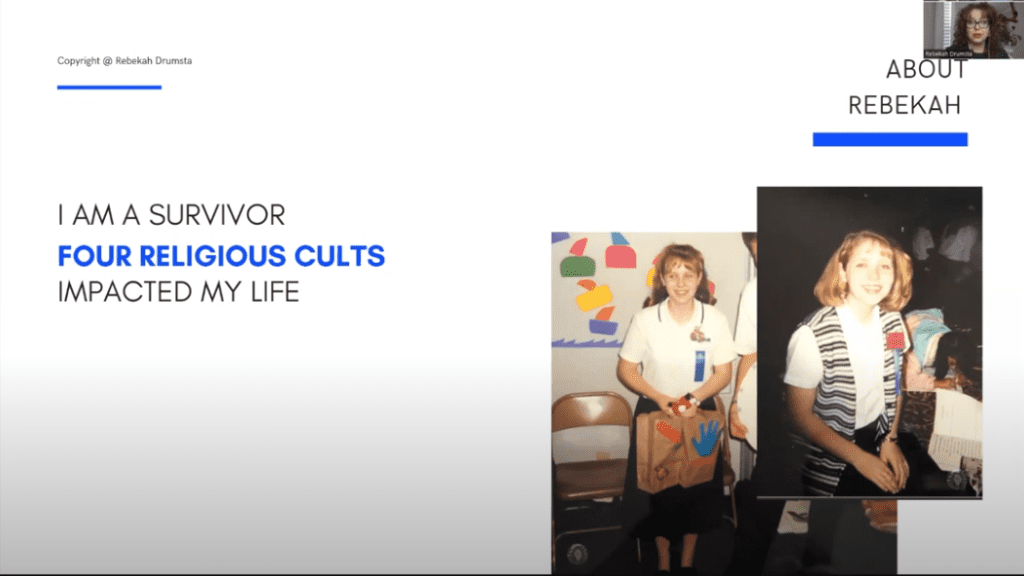
Those are my two earliest memories of religion and even some of my earliest for my entire childhood and that really kind of sets the tone for the rest of it here. In that environment, if you didn’t agree with them, you were rejected or if you didn’t agree with them, you were killed.
Today I’m a wife and a mom. I do a bunch of things within the religious trauma like consulting and advocating for survivors. I’m also the interim CEO of an international nonprofit with DNA identity trauma where you take an at-home DNA test and find out all these surprises. I’m also a board member of the Attachment and Trauma Network as well as the Vashti Initiative, which supports individuals of spiritual abuse and religious trauma.
Religious Trauma
What is religious trauma? We talk about religious trauma and sometimes it’s hard to define. There are a bunch of different definitions that are floating out there and so, I am going to throw some definitions at you, so that might get a little boring, but I want you to understand what I believe things are and how my working definitions and understand that.
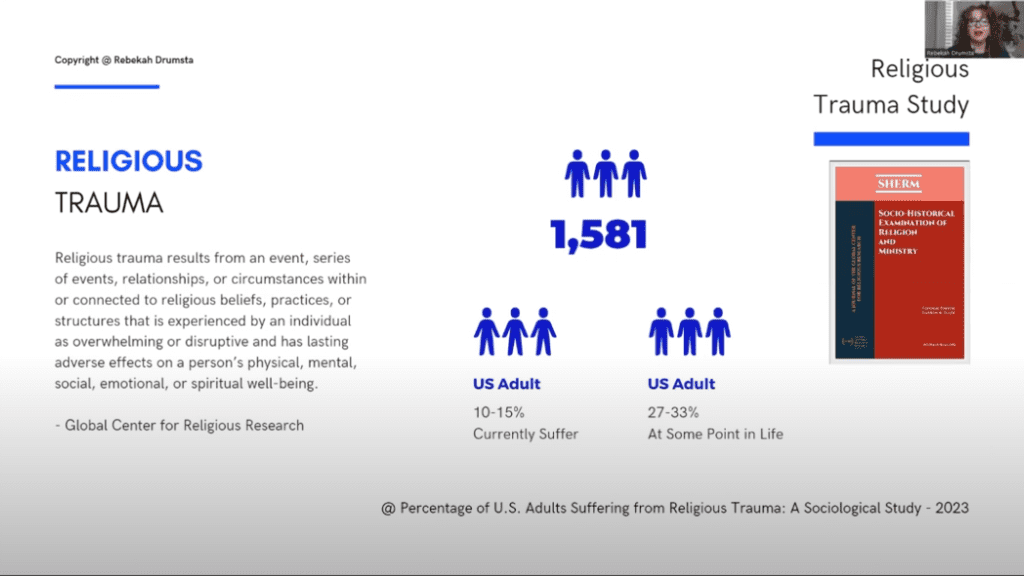
So, the Global Center for Religious Research defines religious trauma as:
Religious trauma results from an event, series of events, relationships, or circumstances within or connected to religious beliefs practices, or structures that is experienced by an individual as overwhelming or disruptive and has lasting adverse effects on a person’s physical mental social emotional, or spiritual well-being.
I was honored to be one of the co-authors on GCRR’s paper on their study on religious trauma where we surveyed over 1500 individuals and discovered that 10 to 15% of adults in the US currently suffer from religious trauma and 27 to 33% of adults in the US, at some point in their life, have experienced religious trauma. So, at 10 to 15% right now, if you’re processing religious trauma you are not alone. There are a lot of us who are processing this who are working through the religious trauma right now today so just know that you are not alone.
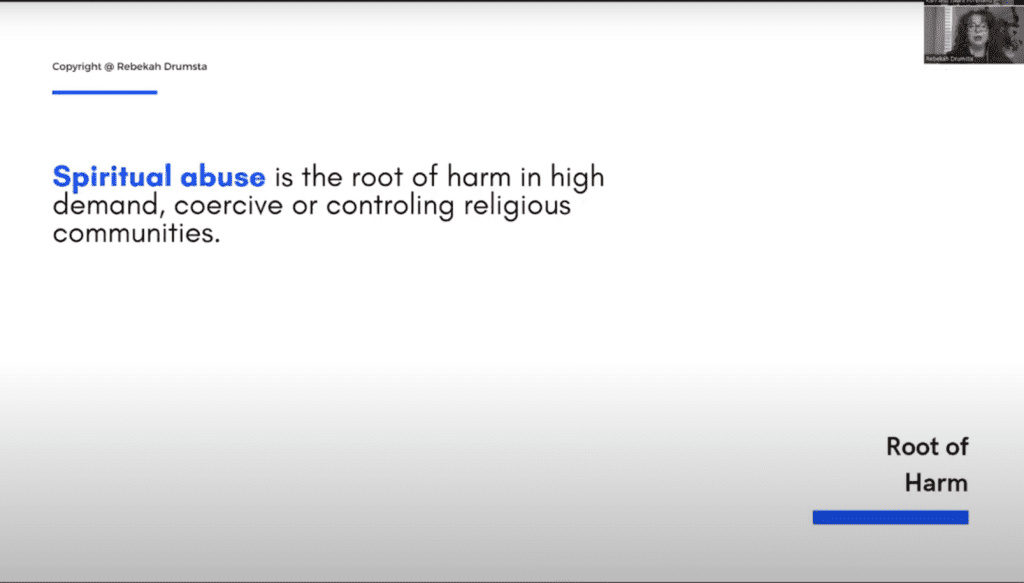
Spiritual Abuse
So, what is spiritual abuse? I believe that spiritual abuse is the root of harm in high-demand, coercive, or controlling religious communities. It’s using one’s power or authority to control, guilt, manipulate, or coerce another with claims of biblical or spiritual truth. This includes psychological or emotional manipulation and coercion using spirituality which undermines or completely removes a person’s autonomous spiritual empowerment and focuses on external spiritual performance.
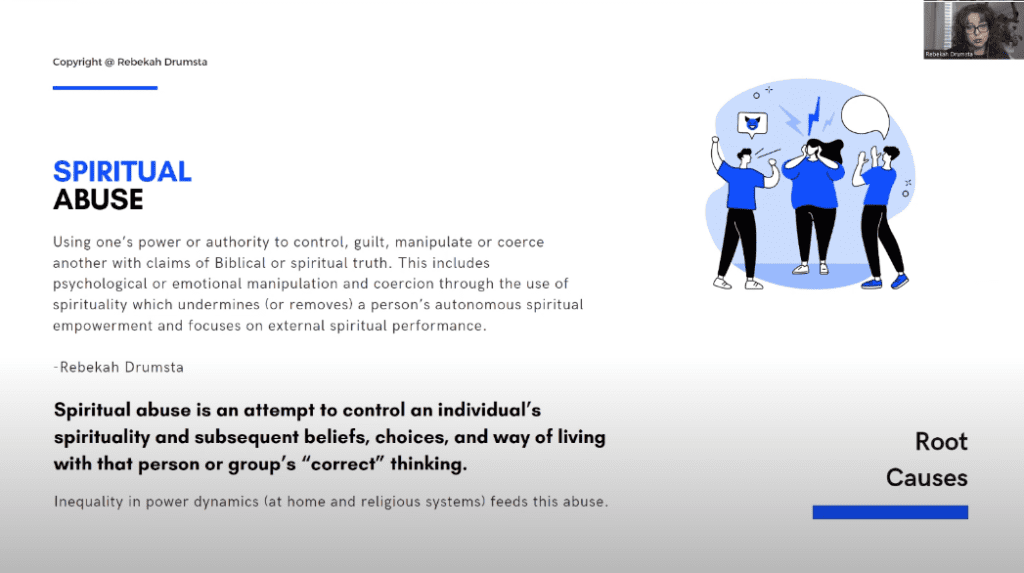
So, in other words, spiritual abuse is an attempt to control an individual spirituality subsequent beliefs and choices, and way of living with that person or group’s “correct” thinking There’s always an inequality of power dynamics the spiritual abuse can come from inside a home. It can come from inside a religious system, inside a church, inside a yoga group, or anywhere where there is spiritual leadership, and that power dynamic is different. So that’s what feeds this spiritual abuse.
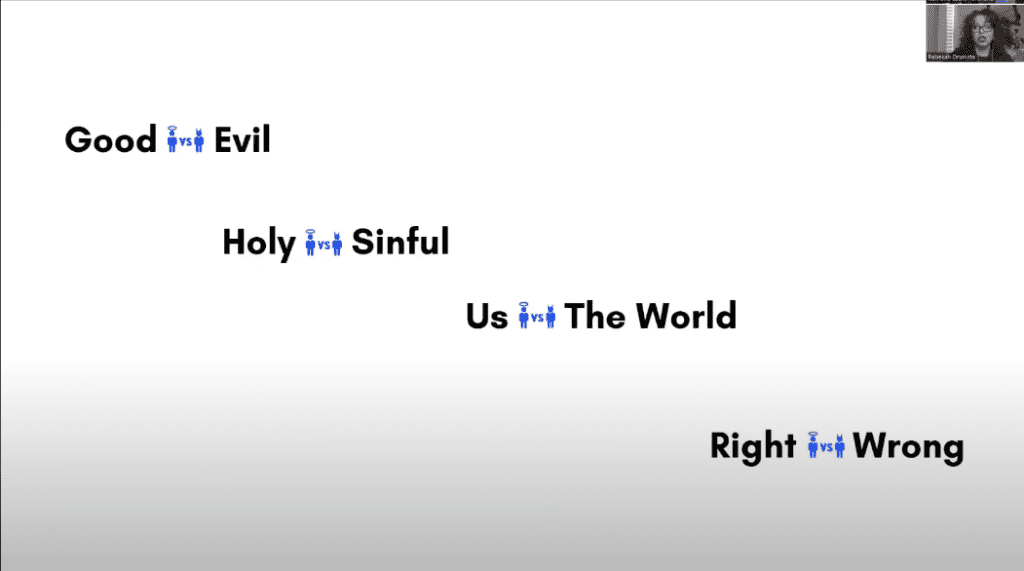
In these types of environments, you will see that good versus evil, holy versus sinful, US versus the world, right versus wrong, and that’s just the US versus them mentality.
Power and Control
Whenever there’s abuse, whether we’re talking financial abuse, physical abuse, emotional abuse, or spiritual abuse, there is someone struggling to have the power or maintain control there’s always that power and control dynamic.
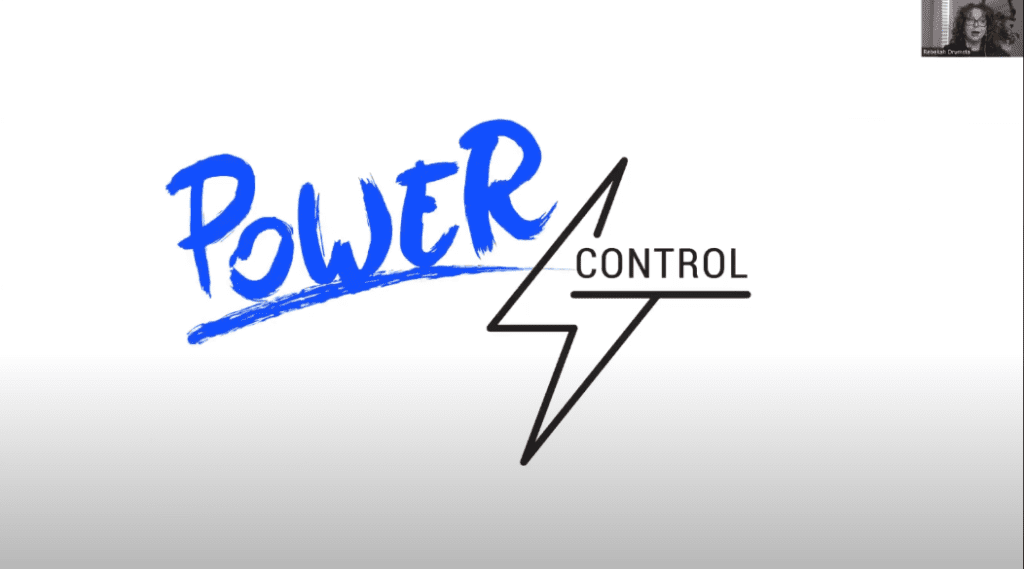
So, part of my childhood included Bill Gothard’s organization called IBLP and you may be familiar with it because of the recent documentary called Shiny Happy People and Bill Gothard never tried to disguise this concept of authority. He developed the umbrella of authority which has seeped into Evangelical culture and the umbrella of authority gave all this power and it was the cornerstone of everything we kids raised inside of there. It was the Cornerstone for everything.
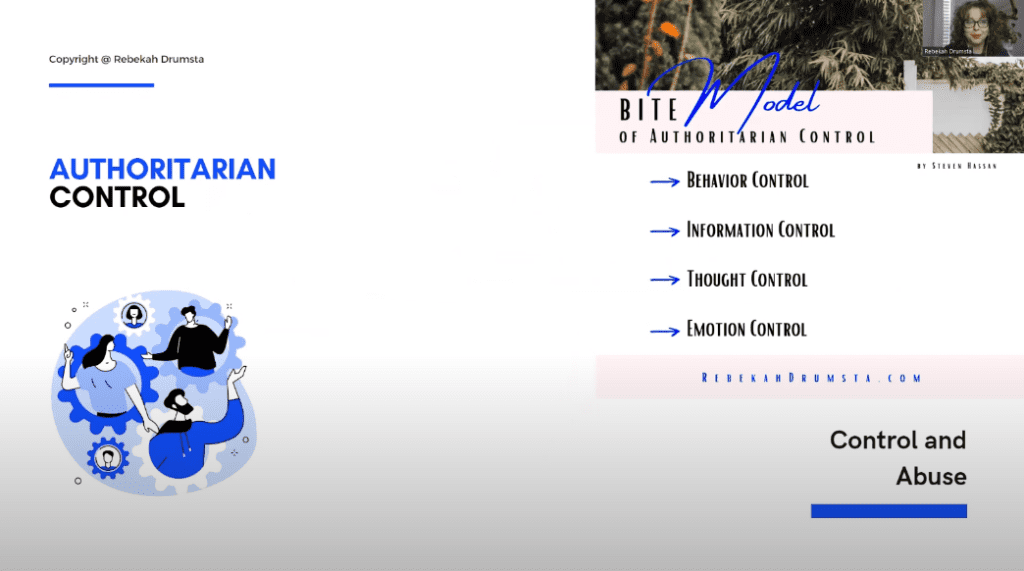
Steve Hassen, one of the leading cult experts in the United States, developed something called The BITE Model of Authoritarian Control. So, you might be saying “I wasn’t raised in a Christian cult, so I didn’t have that.”
But perhaps there was some authoritarian control in your system. So, does that mean that perhaps your behavior was highly controlled: the things you could and could not do, the places you could and could not go?
Was there information control where only certain sources were accepted? Were there banned books in your home or your church? Were there things that you could not watch? Were there limited sources for news and only certain Christian authors you could read?
Were your thoughts controlled? Inside the Bill Gothard World, as children, we were taught to take our thoughts captive—lock them up and throw them away—because we had to control any thought that came into us. There were strongholds that the devil could set up inside our lives, and by controlling all our thoughts. If we had a thought like “I’m mad at Mom!” That was a sin, and we were required to lock it up and throw it away.
We had to control our thoughts and our emotions. They assumed the feeling of anger in my world was a sin. Not that I hit my brother because I was mad. I felt anger so that was wrong.
While there may not be specific cult things in a lot of religious environments, very often it is this authoritarian control that is quite obvious.
Unhealthy Beliefs
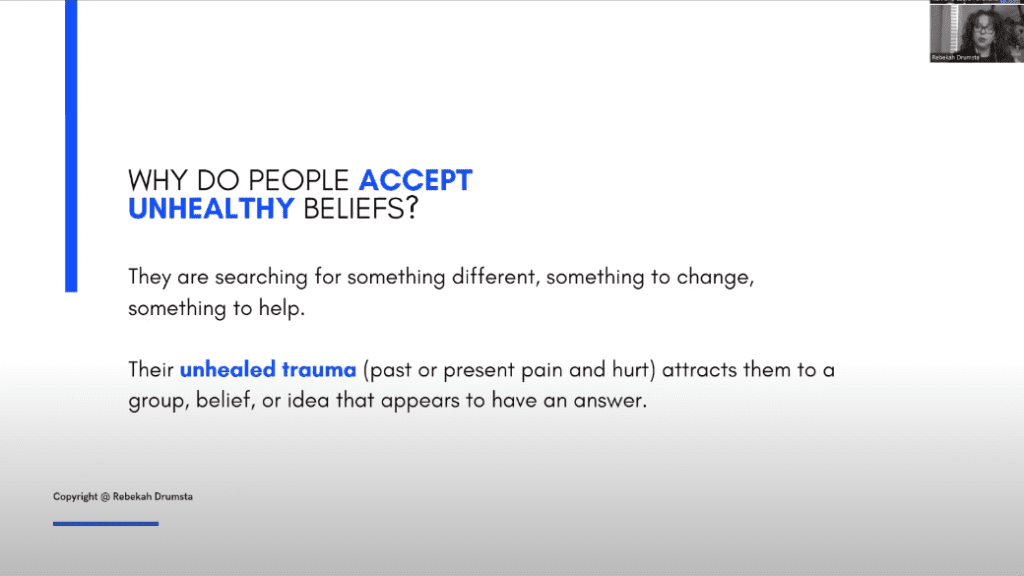
Why do people accept unhealthy beliefs?
What gets people into these situations in the first place?
We are often searching for something different, something to change, or something to help us heal our trauma. Our past or present pain and hurt attract us to a group, a belief, or an idea that seems to have the answer.
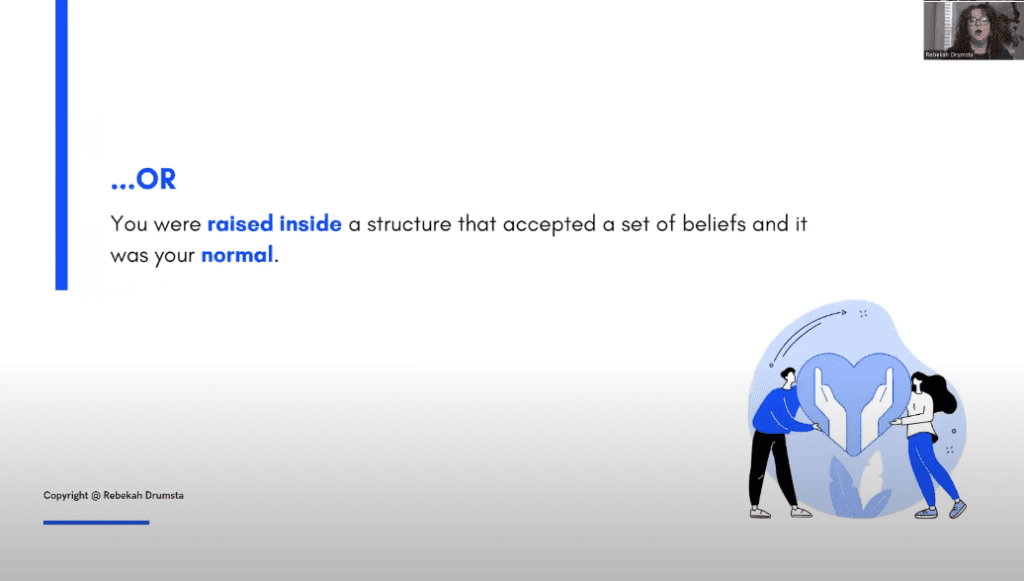
If you were like me, you were just born inside of it. You were raised inside this structure that accepted that set of beliefs and that’s all you’ve ever known. It was your normal. So, individuals that have unresolved unhealed trauma or unhealed abuse in their past, gravitate towards what feels normal. It is part of Being Human and we just go to what we’re used to.
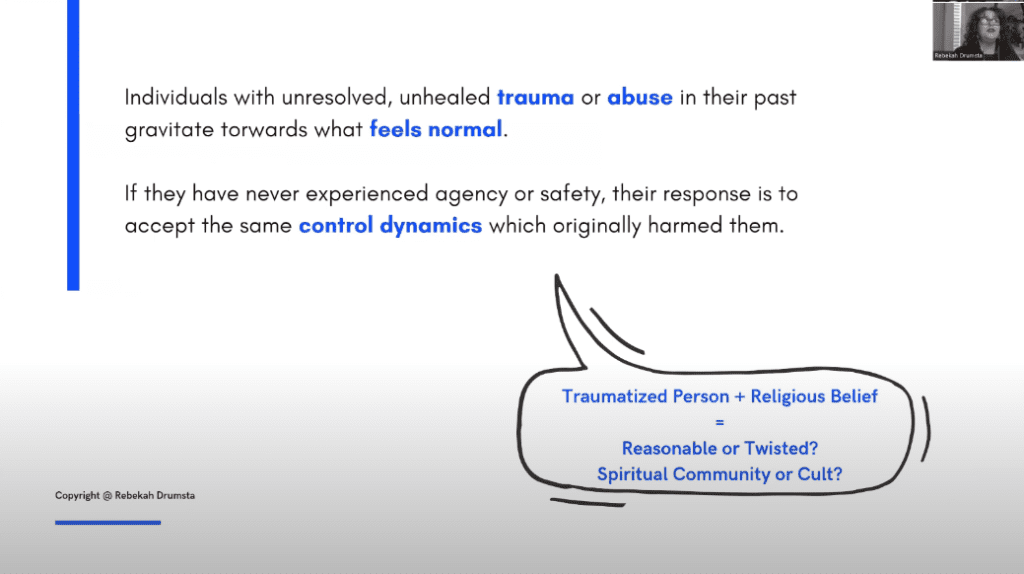
If you’ve never experienced agency or safety or you’ve never felt empowered, your response is to accept the same control dynamic that originally harmed you. So, if you take a traumatized person and mix it with this new religious belief or idea about life whatever it might be, what’s going to happen? Are we going to have a reasonable belief or outcome or is something going to be a little twisted? Are we joining a spiritual community or a cult?
I grew up in the independent Fundamental Baptist Church. There’s a documentary being released quite soon that shares about all the abuse from the entire denomination and I thought when I moved from that specific denomination into another denomination that allowed me to wear pants (because I had only worn skirts my whole life), suddenly now I was free I had so much freedom to wear pants. But because I didn’t recognize all of the hurt and the toxic theologies and all these things in my life, I felt free, but the control dynamics of that church structure were the same—I just felt that I’ve been free.
What is healing?
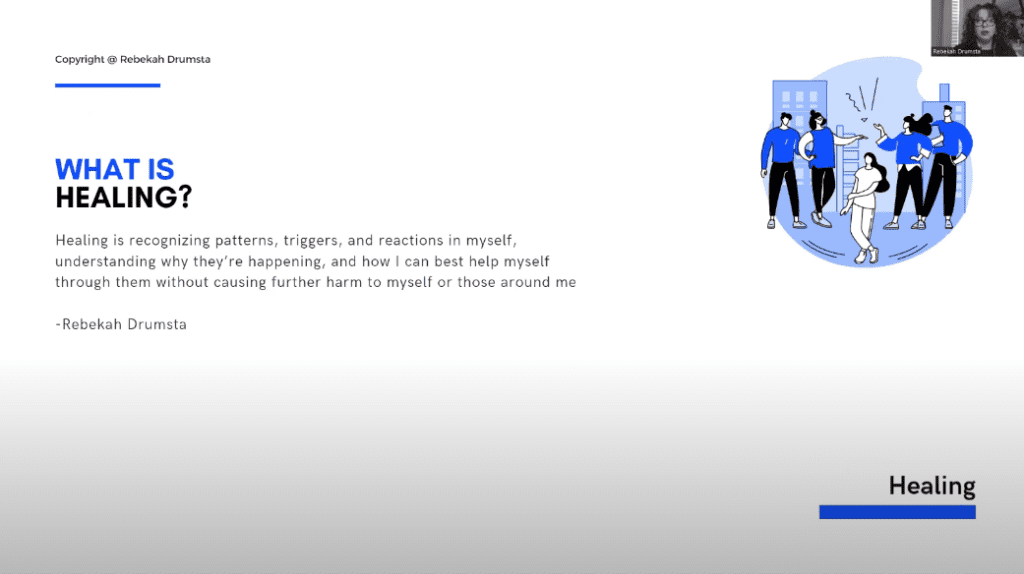
Healing is a word you see everywhere, but what is it?
I Define healing as recognizing patterns, triggers, and reactions in myself, understanding why they’re happening, and how I can best help myself through them without causing further harm to myself or the people around me.
Why is healing so important? Why does everybody talk about healing?
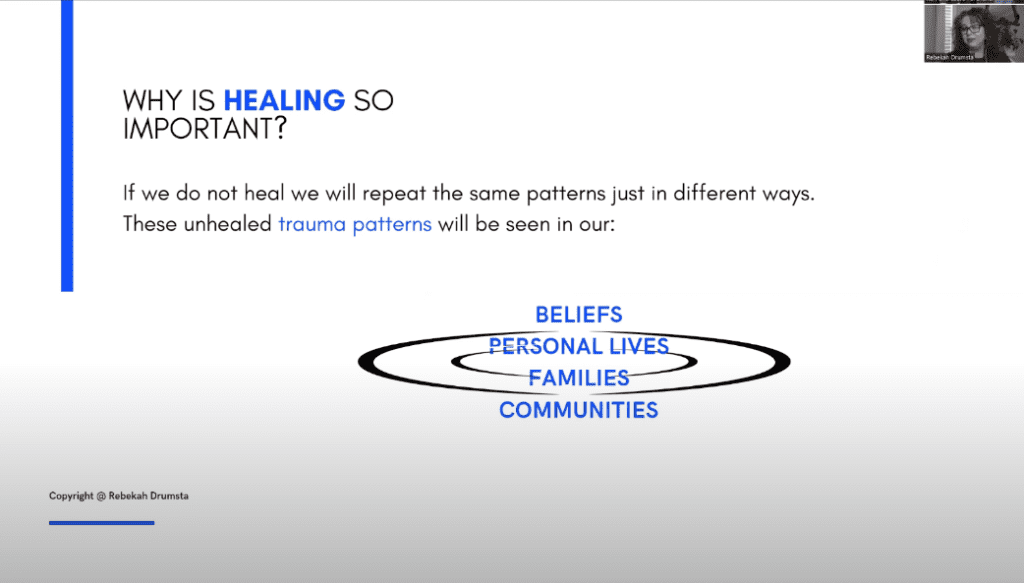
Because if we don’t heal, we will repeat the same patterns just in different ways. The unhealed trauma patterns will be seen in our lives our beliefs our families our communities. So, like I said, I was raised in this toxic, cultish, religious world. But I was the kid caught in that ripple effect. Someone else had joined the organization because of their unhealed trauma pattern and I was like the collateral damage.
One of my greatest encouragements right now to people who do still identify as Christian in the United States or those in the deconstruction movement, we have to stop long enough to heal or we’re going to take the very patterns that we are rejecting—the very dynamics that we see as abusive—if we don’t stop and heal our hearts, we’re going to take elements of that into the new systems and our families and our communities and that ripple effect is going to happen all over again.
Band-Aid, Stitches and Scars
When we realize religious trauma, we might admit, “I may have been abused spiritually I was in an unhealthy home. I was in an unhealthy church or religious program.” The first thing we want to do is how do we fix it. How do we fix it? Well, we like to take the easy way out.
Band-Aids
So often, we grab a Band-Aid that seems good enough. We surmise, “I don’t need to go to the doctor.” We’ve been wired with something called spiritual bypassing where we just pray about it, give it to God, read our Bible more, or go to church more. So, our first instinct might be those Band-Aids of “I’m just going to pray about it. God has got it because that’s what we’ve been told.
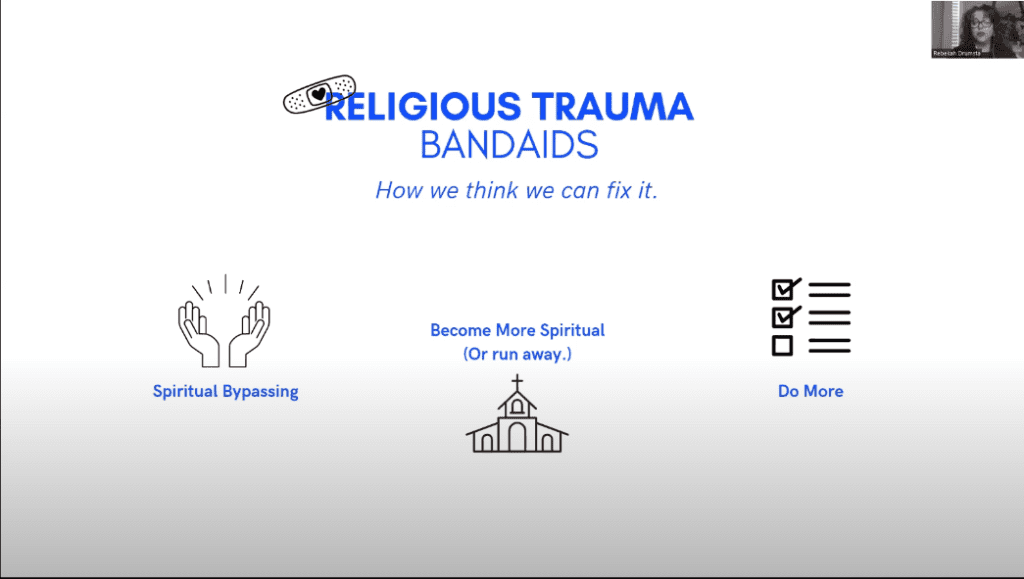
We also might be tempted to do one of two things when we realize something’s off— something is wrong—how do I fix this? What do I do? You might be tempted to become even more spiritual. But becoming more spiritual, such as going to Seminary or reading more books, or and going to church and taking more conferences and doing all these religious things. The problem with that is that can lead to something called religiosity.
If we’re coming from an unhealed place of trauma and hurt, we can go into this place of religiosity where we have to do all these things, or we simply give up and run away. It’s human nature. It’s that pendulum swing. We go from one extreme to the other extreme. We may completely abandon everything about our faith. We assume if that hurts us, we are done! if that is your choice, I challenge you to make sure it is done from a place of healing. If you do choose to become more spiritual or you do choose to walk away from the faith that you grew up in, I ask that you just please stop long enough to heal to make sure that that is a decision that you want to make, and it’s not just a reaction to the hurt and the harm that you’re feeling.
The third band-aid is to do more! Some people might jump into alcohol or drug addiction. We might start volunteering we might over-commit ourselves. We might overcommit ourselves to all these things. We stay busy because we were taught to stay busy in the church constantly working, volunteering, and constantly doing more. But also, because seems to fill that void of “I don’t want to stop long enough to fix this I don’t know what I’m feeling.”
Those are some of the Band-Aids that we think we can just slap on when we recognize that there is hurt. But then as we go deeper, we realize that Band-Aids are not enough. We have to go down deep and assess how deep this cut is and how deep are these wounds. It takes a lot of courage. It takes a lot of bravery for us to stop and analyze this might be the deconstruction time when we begin to separate the pieces and analyze the parts. By doing this, we see what happened to us, we see the real problems.
The Stitches
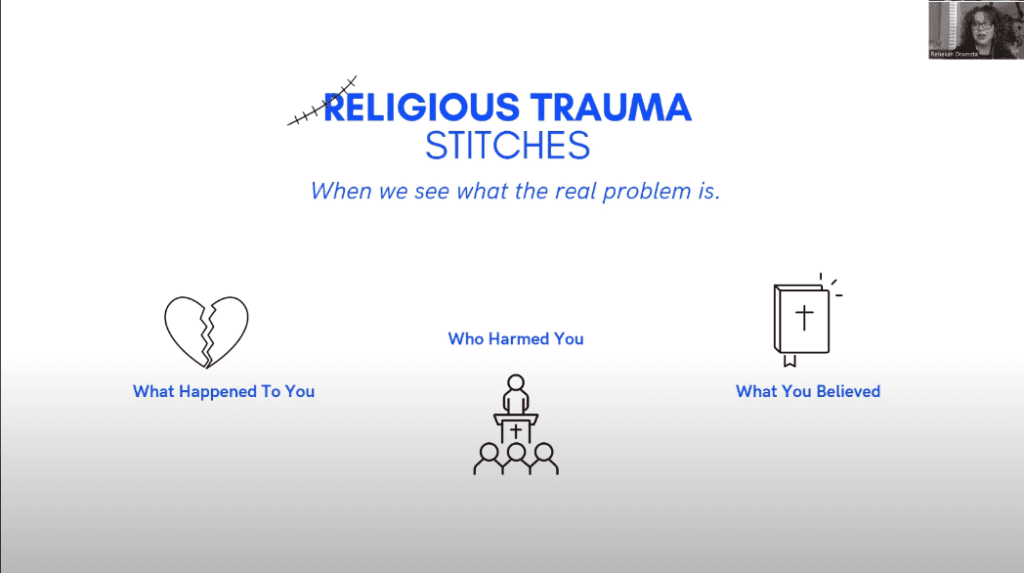
This is what happened and that’s one little Stitch we understand who harmed us. This is what happened—my family believed this, or the pastor believed that, or this community did this or this person assaulted me, or this person controlled me. We begin to name it for what it is. We begin to see what we believe so every time one of those little moments happens, that’s one more stitch that’s one more stitch that we are beginning to treat our religious trauma the way it should be. We understand what that real problem is.
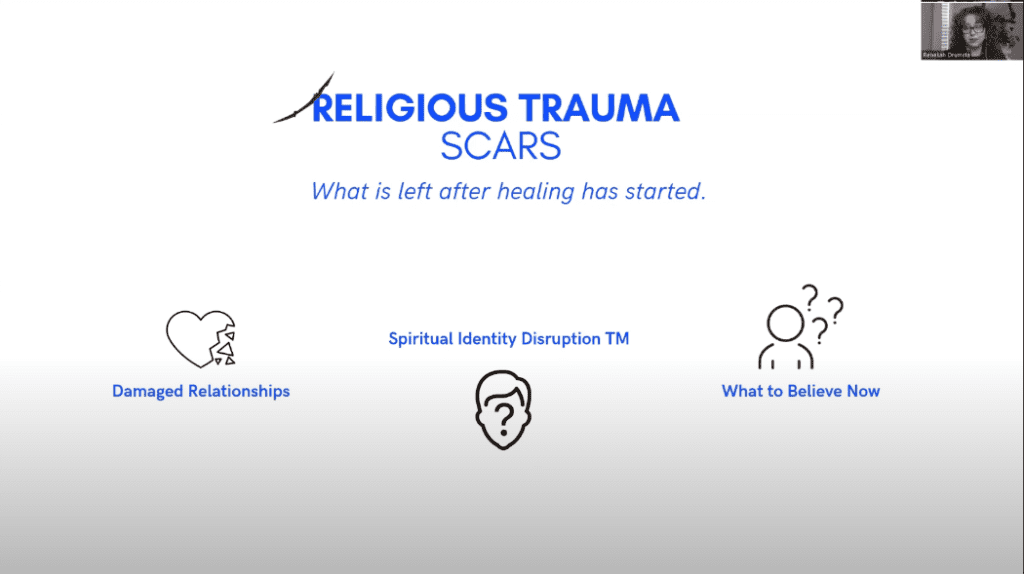
The Scars
This blog originated from a conference powered by women called Leaning Forward in December 2023. Because it was all women speaking, I felt empowered to talk about my C-section scar. It’s still there and sometimes it still hurts because there were nerve endings there when they had to slice me open so that my baby could live.
That’s what happens with religious trauma.
We have started healing and we decided a Band-Aid is not enough we started digging in a little deeper one stitch at a time. But now that we see it’s okay, we start recognizing that it’s beginning to heal but just like my c-section scar there are reminders that it’s still there.
So, we may have damaged relationships. I know a lot of us have friends from our childhood we might have grown up together 20 years, in the same church, and they won’t talk to you anymore. You may have family members that say that if you’re going to believe that I am never talking to you again. They believe you’ve turned your back on Christ. You may get labeled a heretic. At this point, I just quote pink at that point. But we have damaged relationships marriages often don’t survive religious trauma then it gets handed down to our kids we’re raising children while we’re healing from this. So damaged relationships are one of those tender spots that are always there even though we’ve already started healing.
There is something called Spiritual Identity Disruption. It’s a model that I created because I didn’t feel like deconstruction was a word that fully captured the experience that I had watching my friends, my clients, and other people around me were experiencing. Spiritual Identity Disruption is the entire picture. Deconstruction is What do I believe? Is it toxic or is it healthy? Why do I believe it? It is the dissecting of the belief. Spiritual Identity Disruption is when we suddenly say that this affects our political views. This affects my parenting. This affects my marriage. This affects what I thought was gospel truth. it affects how I cook because I used to believe I had to have meat, two vegetables, and bread on the dinner table every meal.
So that was the identity disruption and there’s more about it on my website if you’re interested. It was this process that we go through of understanding it’s not just my religious beliefs—it is my entire life.
I recognize all this harmful stuff but then we’re left thinking now what do I do next? Sometimes even though we feel like we’re good, I’m telling you it’s another layer and that’s part of the identity disruption. I feel like I’m good and then, boom, something happens and it’s another layer. What do I still believe? I don’t know, do I? Those types of questions surface in religious trauma healing.
Religious Trauma Healing
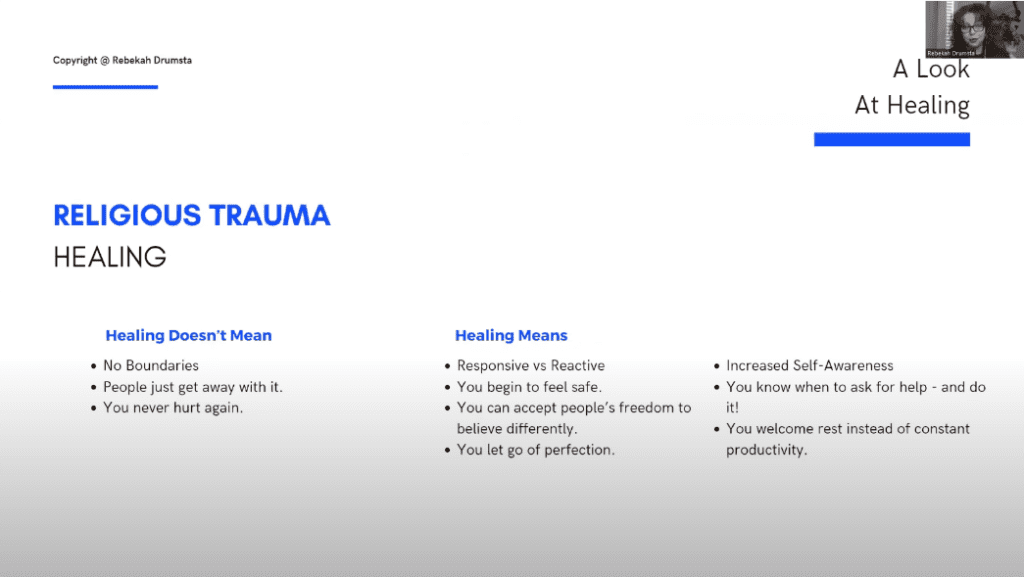
Let’s look at it a little bit more at what healing is. What it does not mean is that there are no boundaries. When we’ve been raised in those controlling religious environments, often boundaries are something we were never allowed. We never understood boundaries and so we have to start with our boundaries with ourselves. That does continue to expand out and healing doesn’t mean that you can’t place a boundary with the people who are still in your life or from your past. It’s very important actually that we do. It does not mean that people just get away with it. Even though we are healing from religious trauma it doesn’t mean that everybody just gets a free pass. We can still speak our truth and tell our story. It doesn’t mean that evil gets to win. It also unfortunately doesn’t mean that you will never be hurt again.
What healing does mean is that you learn to become responsive instead of reactive. you begin to feel safe maybe in your own body for the first time. We were taught the world was such an evil place. It was characterized as us versus the world. We were taught it was evil. Then we started realizing this is a pretty cool place sometimes. We start to feel safe in the world. we accept people’s freedom to believe differently. This was huge for me because when I first started coming out of the fundamentalist faith and the cult control dynamics, I was angry. After all, I supposed, How dare they believe this stuff? How dare they have taught me all of this?
Then one day I realized if I honestly believe in freedom of thought and freedom of choice, that everyone from my past has the freedom to believe that stuff. I also now have the freedom to say how it harmed me. But they’re completely free and when we recognize that people have the freedom to believe differently from us, it takes that weight off our shoulders.
Healing from religious trauma also means you start to let go of perfection.
How many of us had to perform on stage for worship teams? For all of this stuff, we had this level of perfection that we had to keep constantly this image that we are the image bearer of Christ. For me, I was the image of the homeschool world and the homeschool movement that had started. So, I had to look good every time I left the house.
There is an increased self-awareness when we begin noticing and that’s a really good sign that that healing is in play. Remember how I defined healing that included self-awareness of recognizing patterns and triggers about how to help yourself through it and how not to harm others or yourself?
We begin to welcome rest because we know how to ask for help. We recognize we need to rest. We might ask our husband for a weekend off and ask him to watch the kids because we need to go to the park and just sit and stare at the ducks on the pond. We recognize or say, “I’ve got to go to therapy I need to go talk to somebody about this.” Instead of that constant productivity and that constant perfection, we recognize it and also see that rest is part of healing.
Recovery Tools
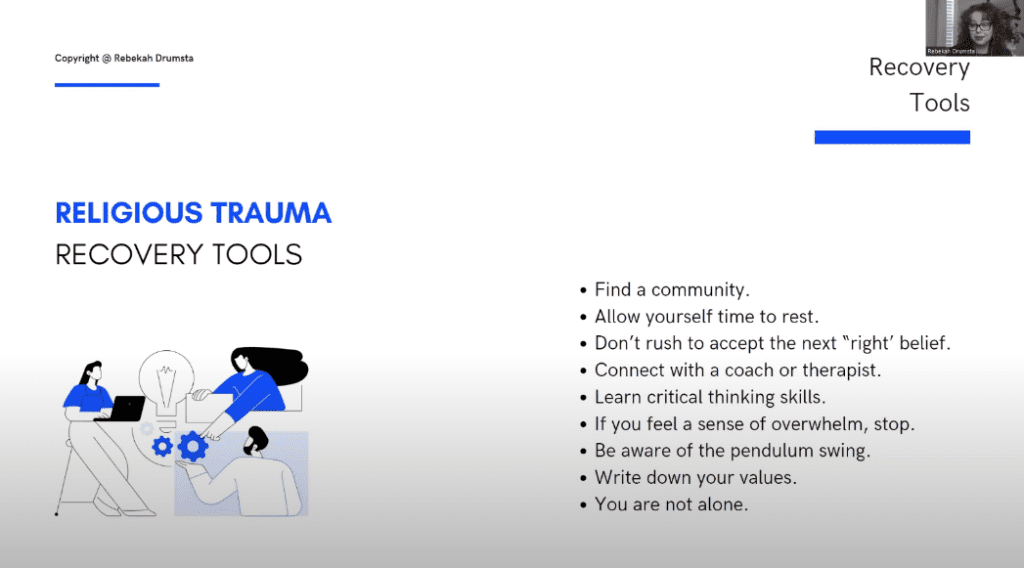
What are some helpful recovery tools so tools for us as we’re trying to heal from our religious trauma?
Find a community. 15 years ago, when I began deconstructing, there was nothing available. I felt so alone, and I would Google I’m questioning my faith. It was the spiritual bypassing stuff like Just pray about it—Just talk to God—Go talk to your pastor. There was no help. So, find a community. That might mean there are a couple of folks that you grew up with who are in the same place, and you meet over Zoom or meet over coffee once a month. Join a Facebook group that provides that community/ I didn’t have it and now all these years later I have this tribe of people around me and I am seeing this is what was missing in my process.
It’s that rest thing again. Allow yourself time to rest. So often, we kept going and going and going and going. There were church schedules and the performance and the doing. Allow yourself time to rest and don’t rush to accept the next right belief. I had a client who called a frenzy because they were hearing stuff in the news and I didn’t know what they believed about it, and they needed to make sure that they knew what they believed about it. I was like, Why? What do I believe about LGBTQT? What do I believe about racism? What do I believe about the patriarchy and what do I believe about and just spiraling because they were trying to wrestle with 15 things because they were taught, that they have to have an answer and be ready at any moment to give an answer to any man who asks you the reason of the faith and hope that is in you with meekness and fear.
We’ve been taught to have the answer right now. But we don’t have to. We don’t have
to rush to accept that new right answer now.
Connect with a coach or a therapist. Find somebody. Employ the hand up the hand down concept. You can help someone with your bravery and your courage right now! By going and seeking help seeking professional help, you may need to learn some critical thinking skills and how to make decisions. I recently had a friend who just looked at me and said, “Rebecca all you have to do is practice it. You have everything you need to practice it. And you’re going to screw up. you’re going to make mistakes. But that’s part of practice.”
So sometimes we have to learn these skills and how to make decisions or how to think not just be told what to think. We learn how to analyze information for ourselves and find it for ourselves you will make mistakes. But we have to practice. When we feel that sense of overwhelm like my client did, it’s time to stop—it’s time to rest.
Be aware of that pendulum swing. We are tempted to go to the opposite. Watch out for that and use those critical thinking skills. I completely support your decision to go where you need to go, but only if it is from a place of healing and intention, not reaction.
Write down your values. What is it I believe and think? I don’t believe anything right now I’m scared. I don’t know! Write them down and whenever you question that again, you can go back to the list you can subtract, you can add, but you have more morals, values ethics, and beliefs that are still core to you than you realize.
You’re Not Alone. 10 to 15% of Americans right now are struggling through religious trauma.
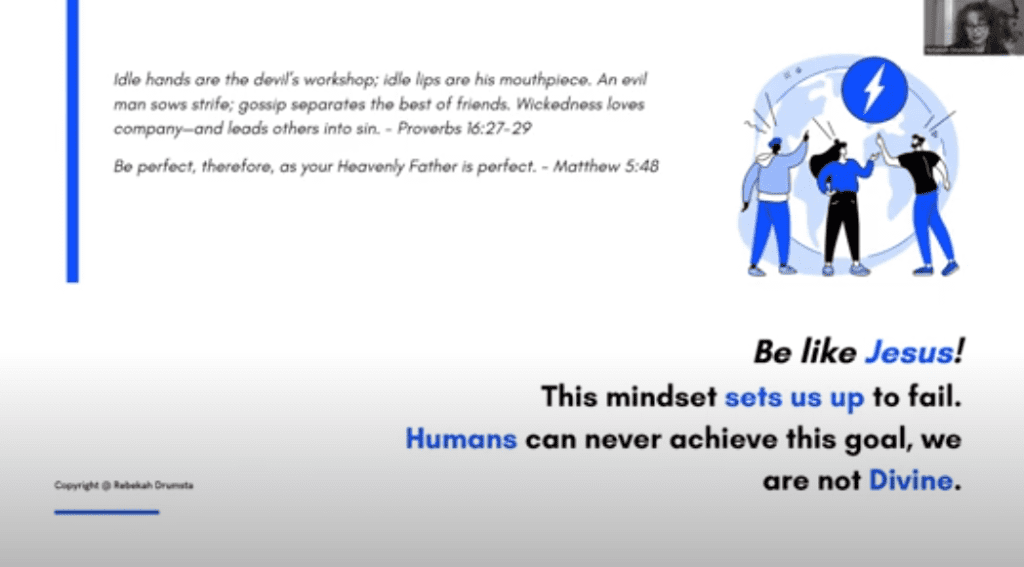
Before I close, I want to make sure that you know that this mindset that we were given is going to set you up for failure. We were told to be like Jesus. If you grew up in church, you most likely want to be more Christlike. You want to be like Christ. You want to be like Jesus. Well, you’re going to fail because you’re not Jesus. Humans cannot achieve that and if you still identify as Christian, you can look to Jesus as an example and be like, okay, how did Jesus handle stuff? Just like the WWJD stuff, what did he do? But do not hold yourself to that level of expectation because every time you’re going to fail. We were taught to be perfect as your heavenly father is perfect and the whole concept of keep working keep working keep doing Idle hands are the devil’s workshop.
We were taught this stuff and we kept going. That’s a toxic environment, trying to get you to achieve something that’s never going to happen, and then never stopping trying to achieve something that’s never gonna happen. Process that. Analyze that. Why am I working so hard? You don’t have to.
Am I / Was I in a Religious High Demand Group?
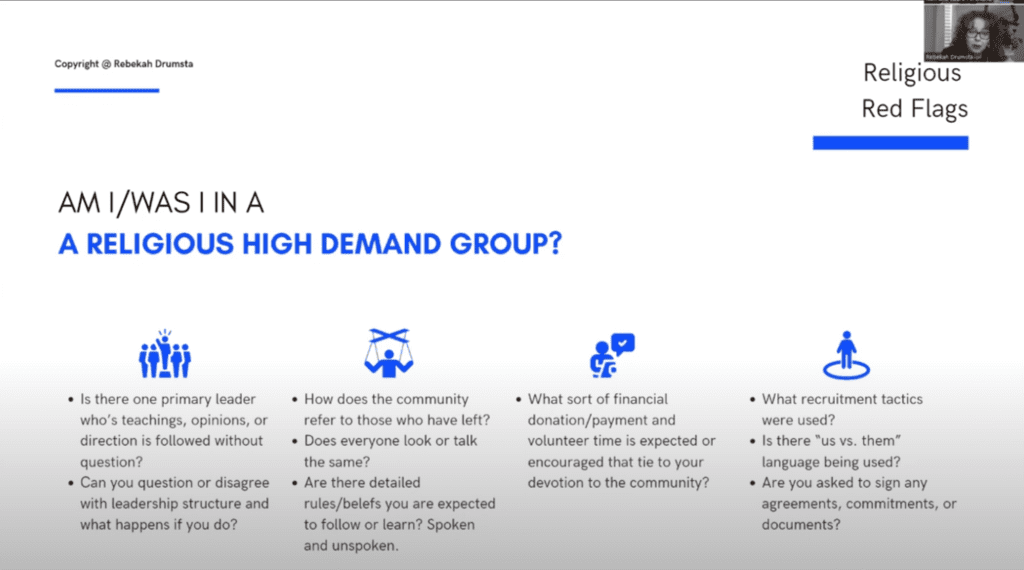
Were you in a religious high-demand group?
How do you know if it was just a little church that made some mistakes along the way and some of what they believed caused harm?
How do I know if it was a high-demand group or not?
Let’s look at a couple of things.
- Was there a primary leader whose teachings opinions and direction were followed without question?
- If people did question that leader or the structure that was in place, what happened?
- How did the community refer to people who left?
- Does everybody look or talk the same?
In my church, all the women wore skirts knee-length or longer. Our youth pastor had culottes, the big puffy ones so that if a teenager walked in to come to youth group they would have the girl put those on if she was wearing pants or shorts. We all had to look the same.
- Are there detailed rules or beliefs that you’re just expected to follow or learn a lot of them aren’t even spoken, they’re just understood.
- What sort of financial donation payment and volunteer time is expected or encouraged that shows your devotion to Christ or the community?
- What recruitment tactics are used to bring new people in?
- Is there that US versus them language or US versus the world where we have the truth they don’t?
- What have you been asked to sign? Are there any documents or agreements where you are asked to sign over property? Are you asked to sign? Is it legally binding?
Watch out for those things.
My Own (Religious Beliefs)
If you are processing any kind of belief, whether it is political, religious, or spiritual, and you’re not sure be where to go, let’s ask this. Pick a belief and ask yourself:
- Who does that belief silence, harm, oppress, liberate, center or give power to?
And then the beautiful question that we should all learn from: WHY?
- Why does that belief harm that person?
- Why does it silence them?
- Why does it give them the power?
For my current Beliefs:
- Where did I learn this? Was it a pastor? Was it grandma? Was it a guy in college or was it just my own lived experience that led me to this conclusion and so where did I learn it?
- Where did that person learn it? Keep tracking back your beliefs. Where do they even come from? What is the root? What’s the source?
- Why is this belief so important to me?
- What would happen if I changed or let go of this belief? Would it change my family would it change myself? Would I feel like I’m making God angry? Would I feel like I’m going to go to hell?
- What would happen if you changed or let go of that and go back to the beautiful question of children…WHY?
No matter which stage you are in (band-aid, stitches, scars), you are not alone, and you are going to make it!
Rebekah Drumsta
Rebekah Drumsta has held a global presence by devoting her efforts to various nonprofits and organizations. Her diverse background includes educational and mental health content development, international relations, and public speaking.
Rebekah Drumsta Resouces
If you share the videos, please use this page to share as it contains pointers to resources, etc.
 About Karl Forehand
About Karl Forehand

